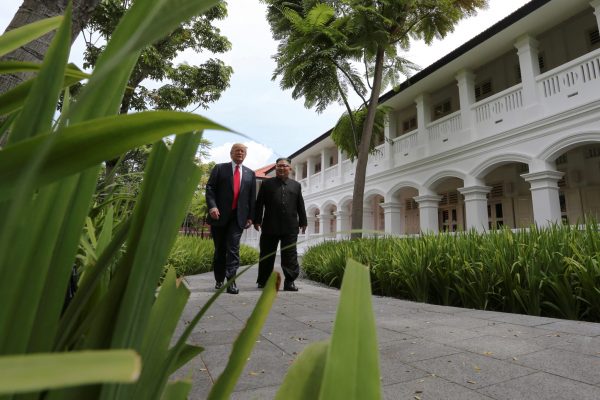On 12 July, one month after the summit, Trump brandished a letter from North Korean leader Kim Jong-un, who declared their Singapore meeting ‘the start of a meaningful journey’ and said he was looking forward to their next meeting. Trump took this as a reflection of the ‘great progress’ that the two countries had made despite the frustrations that had beset US Secretary of State Mike Pompeo in his recent visit to Pyongyang. Six weeks after the Singapore summit, North Korea’s nuclear arsenal has not diminished, US and UN sanctions against North Korea remain in place, and the US government continues to forbid US citizens from visiting North Korea (and vice versa) without special permission.
Still, despite the largely critical coverage from the Western press — the media in Asia, including in South Korea, has generally been more positive — it is far too early to tell whether the Singapore summit was a success or a failure. Kim’s ‘nice note’ is correct: the meeting of the two leaders was only the start of a journey and was the beginning of a long and unpredictable process of normalising relations between two countries that have been in conflict for 70 years.
As critics were quick to point out, the joint declaration was remarkably vague — not much of a ‘deal’ at all. Trump offered North Korea unspecified ‘security guarantees’ in exchange for which Kim Jong-un ‘reaffirmed his firm and unwavering commitment to complete denuclearisation of the Korean Peninsula’. The one concrete action proposed was the return of US soldiers’ remains from the Korean War. Here some progress has been made: according to a US official who was present at the North Korea–US talks on 16 July, North Korean has offered to send back the remains of over 50 US servicemen on 27 July, which is the 65th anniversary of the Korean War armistice.
The summit was oversold in North Korea as well. The Trump–Kim meeting was covered extensively in the DPRK media, and the usually virulent anti-US propaganda has softened. There has been a new focus on economic development in recent months, and the summit was supposed to be a breakthrough moment that allowed North Korea to shift from nuclear weapons to rebuilding its economy. But the economy still languishes; according to the Bank of Korea in Seoul, North Korea’s GDP shrank by 3.5 per cent in 2017 — its worst performance in two decades. On 20 July, Pompeo reiterated the US position that sanctions could not be lifted until North Korea takes further steps toward denuclearisation, and he criticised Russia and China for failing to enforce sanctions on North Korean oil imports.
As with US–Russia relations, there can be a sizable gap between statements from the White House and the actual policies of the administration. While Trump and Kim (as well as South Korean President Moon Jae-in) emphasise peace and cooperation in more general terms, Pompeo and others in the administration speak the old language of CVID (complete, verifiable and irreversible dismantlement of North Korea’s nuclear program) as a precondition for any change in the US–North Korea relationship. These two approaches may be complementary, but more often they appear contradictory and confusing. Trump himself seemed to walk back on his bullish statements on North Korean denuclearisation by announcing on 20 July the ‘unusual and extraordinary threat’ North Korea still poses to the United States.
In the meantime, relations among the countries of Northeast Asia are moving forward — with or without a dramatic change in US–DPRK ties. Russia and China have so far resisted US calls to block oil deliveries to North Korea. Kim’s three meetings with Chinese President Xi Jinping in less than two months reflect the rapidly warming ties between North Korea and China after several years of cool relations. Russian media recently reported plans for a Kim–Putin summit. President Moon spoke to the Russian lower house on 21 June — the first South Korean president to make an official visit to Russia since 1999 — where he called for greater cooperation between Russia and the two Koreas on economic development and denuclearisation.
On the Korean Peninsula itself, the Moon administration remains upbeat about relations with the North three months after the inter-Korean summit in Panmunjom, which called for a peace agreement to replace the Korean War armistice by the end of this year. Reunions of Korean families separated by the North–South conflict are scheduled for August. Joint inspection has started for reconnecting North–South railway lines. But only so much can be done while North Korea is under heavy UN sanctions. South Korea has requested (and received) special permission from the UN Security Council Sanctions Committee to allow the equipment and materials for communication between the two Koreas’ militaries. Establishing liaison offices between the Seoul and Pyongyang governments, another goal of the Panmunjom Summit, faces similar sanctions obstacles.
Dismantling a 70-year-old system of conflict and confrontation is an enormous and complex task. As Pompeo rightly stated, North Korean denuclearisation will take a long time. But the goal to which Seoul, Pyongyang and Washington have committed is not just denuclearisation: the goal is a lasting and stable peace. Building that will take a great deal more patience than we have tended to see in Washington.
Charles K Armstrong is The Korea Foundation Professor of Korean Studies in the Social Sciences at Columbia University and author of The Koreas.

